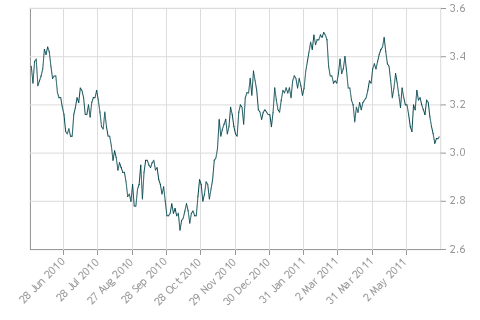The Bank of Canada has kept the target overnight interest rate steady at 1%. This surprised nearly nobody. Their statement is relatively unchanged from the prior one.
The chart to keep looking at is not the BAX futures, but rather the 10-year benchmark government bond yield:
With the yield spread from short-term rates to the 10-year at about 205 basis points, the bank is unlikely to lift rates anytime soon.
BAX futures are as follows:
| Month / Strike | Bid Price | Ask Price | Settl. Price | Net Change | Vol. |
| + 11 JN | 98.695 | 98.705 | 98.695 | 0.005 | 12727 |
| + 11 JL | 0.000 | 0.000 | 98.630 | 0.000 | 0 |
| + 11 AU | 0.000 | 0.000 | 98.615 | 0.000 | 0 |
| + 11 SE | 98.630 | 98.640 | 98.630 | 0.000 | 31347 |
| + 11 DE | 98.500 | 98.510 | 98.480 | 0.020 | 37387 |
| + 12 MR | 98.350 | 98.360 | 98.310 | 0.040 | 24564 |
| + 12 JN | 98.200 | 98.210 | 98.140 | 0.060 | 13081 |
| + 12 SE | 98.040 | 98.050 | 97.970 | 0.070 | 3855 |
| + 12 DE | 97.870 | 97.890 | 97.790 | 0.090 | 809 |
The market has priced in a rate hike by year’s end, but I do not think this projection will come to fruition – come December, the 98.5 price will be likely around 98.7 – a thin value bet could be placed here.
